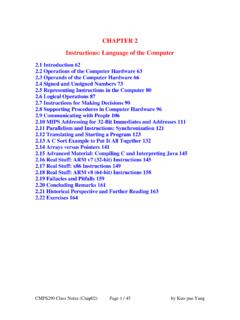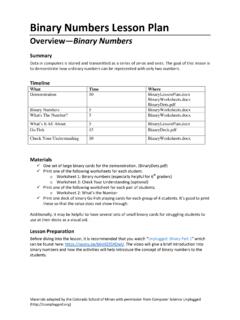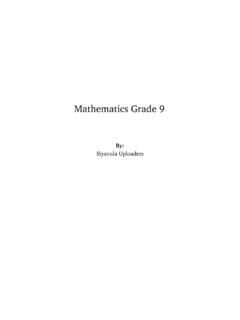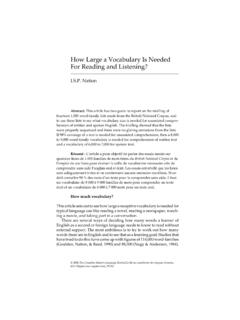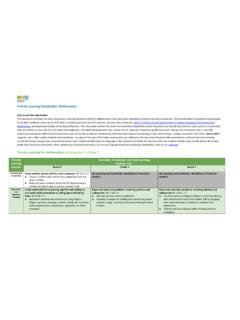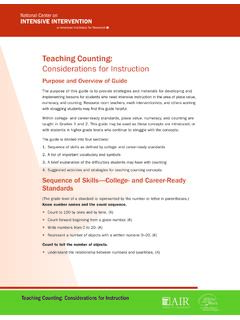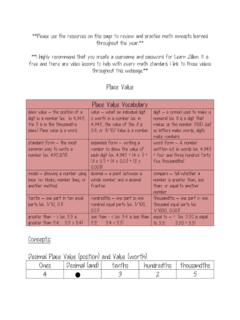Transcription of PHYS 2310 Engineering Physics I Formula Sheets
1 PHYS 2310 Engineering Physics I Formula Sheets Chapters 1-18. Chapter 1/Important Numbers Chapter 2. Units for SI Base Quantities Velocity Quantity Unit Name Unit Symbol Length Meter M . Average Velocity = = Time Second s . Mass (not weight) Kilogram kg . Average Speed = . Common Conversions . Instantaneous Velocity = lim = 1 kg or 1 m 1000 g or m 1m 1 106 0 . 1m 100 cm 1 inch cm 1m 1000 mm 1 day 86400 seconds Acceleration 1 second 1000 milliseconds 1 hour 3600 seconds 1m ft 360 2 rad . Average Acceleration = . Important Constants/Measurements 2 . Mass of Earth 1024 kg Instantaneous = = Acceleration 2 Radius of Earth 106 m 1 u (Atomic Mass Unit) 10 27 kg Density of water 1 / 3 or 1000 / 3 Motion of a particle with constant acceleration g (on earth) m/s 2.
2 = 0 + Density 1. Common geometric Formulas = ( 0 + ) 2. 2 1. Circumference = 2 Area circle = . = 0 + 2 Surface area 4 2. = 4 2 Volume (sphere) = 3. (sphere) 3 2 = 02 + 2 . = Volume (rectangular solid). = . Chapter 3 Chapter 4. Adding Vectors + = + Position vector = + + Geometrically Adding Vectors displacement = + + Geometrically ( + ) + = + ( + ) (Associative Law) . Average Velocity =. = . Components of Vectors = Instantaneous Velocity = = + + . Magnitude of vector | | = = 2 + 2 . Average Acceleration = . Angle between x axis . = Instantaneous and vector =. Acceleration Unit vector notation = + + = + +.
3 = + Projectile Motion Adding vectors in = + Component Form = 0 0 = + 1. Scalar (dot product) = = 0 + 2 2. or = 0 if =0. = ( + + ) ( + + ). Scalar (dot product) 1. = + + = 0 2 2. 2 2. Projection of or = ( 0 0 ) 2 y component of | | = 0 0 Vector (cross) product 2. = Trajectory = ( 0 ) magnitude 2( 0 0 )2. = ( + + ) ( + + ) 02. = ( ) + ( ) Range = sin(2 0 ) . + ( ) . Vector (cross product) or Relative Motion . = + .. = . = | |. Uniform Circular 2 2 = =. Motion Chapter 5 Chapter 6. Newton's Second Law Friction = Static Friction General , = (maximum). , = Kinetic Frictional = Component form , = , = 1. Drag Force = 2 2.
4 Gravitational Force 2 . Terminal velocity = . Gravitational Force = . Centripetal 2. Weight = = acceleration . Centripetal Force 2. = . Chapter 7 Chapter 8.. Kinetic Energy 1 = 2 Potential Energy = = ( ) . 2 . Work done by constant Gravitational Potential = Force = = Energy 1 2. Work- Kinetic Energy Elastic Potential Energy ( ) = = 0 = 2. Theorem Work done by gravity Mechanical Energy = + = Principle of Work done by = + 1 + 1 = 2 + 2 conservation of lifting/lowering object = = + = 0 mechanical energy Spring Force (Hooke's = ( ). Force acting on particle ( ) = law) = (along x-axis) . 1 2 1 2 Work on System by Work done by spring = 2 2 external force = = + With no friction Work done by Variable = + + Work on System by Force.
5 External force = + Average Power With friction (rate at which that . = Change in thermal force does work on an = energy object). Conservation of Energy Instantaneous Power = = = *if isolated W=0. = = + + . Average Power = .. Instantaneous Power = . **In General Physics , Kinetic Energy is abbreviated to KE and Potential Energy is PE. Chapter 9. Impulse and Momentum Collision continued . Inelastic Collision 1 01 + 2 02 = ( 1 + 2 ) . = ( ) . Impulse . = Conservation of Linear 1 + 2 = 1 + 2 Momentum (in 2D). Linear Momentum = . = = . Impulse-Momentum Average force Theorem = = = .. Newton's 2nd law = Center of Mass =.
6 1. System of Particles = Center of mass location = .. =1. = . 1. Center of mass velocity = .. Collision =1. Final Velocity of 2 1 2. objects in a head-on 1 = ( ) Rocket Equations 1 + 2 1 collision where one Thrust (Rvrel) = . object is initially at rest 2 1 1: moving object 2 =( ) . 1 + 2 1 Change in velocity . 2: object at rest = Conservation of Linear . = Momentum (in 1D). = 1 + 2 = 1 + 2 Elastic Collision 1 1 + 2 12 = 1 1 + 2 2 1 + 2 = 1 + 2 Chapter 10.. Angular displacement = Rotation inertia = 2 (in radians = 2 1 Average angular Rotation inertia = (discrete particle = 2 velocity . system).. Instantaneous Velocity = Parallel Axis Theorem h=perpendicular Average angular = + 2 distance between two =.)
7 Acceleration axes Instantaneous angular = Torque = = = . acceleration Rotational Kinematics Newton's Second Law = = 0 + . 1 Rotational work done = = 0 + 2 by a toque 2 = ( constant). 2 2 = 0 + 2 Power in rotational . = = 1 motion . = ( + 0 ) 2 Rotational Kinetic 1. 1 Energy = 2 = 2 2. 2 Work-kinetic energy 1 1. theorem = = 2 2 = Relationship Between Angular and Linear Variables 2 2. Velocity = Tangential Acceleration = 2.. Radical component of = = 2 . 2 2 Period = =. Moments of Inertia I for various rigid objects of Mass M. Thin walled hollow cylinder or hoop Annular cylinder (or ring) about Solid cylinder or disk about central Solid cylinder or disk about central about central axis central axis axis diameter = 2 1.
8 = ( 12 + 22 ) 1. 2 = 2. 2. 1 1. = 2 + 2. 4 12. Solid Sphere, axis through center Solid Sphere, axis tangent to surface Thin Walled spherical shell, axis Thin rod, axis perpendicular to rod through center and passing though center 2. = 2 7. 5 = 2 2 1. 5 = 2 = 2. 3 12. Thin rod, axis perpendicular to rod Thin Rectangular sheet (slab), axis Thin Rectangular sheet (slab_, axis Thin rectangular sheet (slab) about and passing though end parallel to sheet and passing though along one edge perpendicular axis through center center of the other edge 1. = 2. 3. 1 1. = 2 = ( 2 + 2 ). 1 3 12. = 2. 12. Chapter 11.)
9 Rolling Bodies (wheel) Angular Momentum Speed of rolling wheel = Angular Momentum = = ( . ) Kinetic Energy of Rolling 1 1 Magnitude of Angular = Wheel = 2 + . 2 2 2 Momentum = = Acceleration of rolling . = wheel = . Angular momentum of a Acceleration along x-axis , = =1 system of particles . extending up the ramp 1 + 2 . =.. Torque as a vector Angular Momentum continued Angular Momentum of a Torque = = rotating rigid body Magnitude of torque = = = . Conservation of angular = momentum = .. Newton's 2nd Law = Precession of a Gyroscope . Precession rate = . Chapter 12 Chapter 13. Static Equilibrium Gravitational Force 1 2.
10 (Newton's law of = = 0 gravitation) 2.. Principle of = 0 1, = 1 Superposition =2. Gravitational Force , = 0, , = 0 acting on a particle If forces lie on the 1 = xy-plane from an extended , = 0 body Gravitational . = Stress (force per unit acceleration 2. area) Gravitation within a . = = Strain (fractional spherical Shell 3. change in length) Gravitational Potential . = Stress (pressure) Energy . =. 1 2 1 3 2 3. Potential energy on a Tension/Compression = ( + + ) = system (3 particles) 12 13 23. E: Young's modulus . Shearing Stress 2 . = Escape Speed = G: Shear modulus . Hydraulic Stress . = Kepler's 3rd Law 4 2 3.





